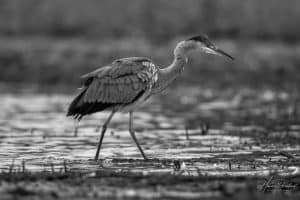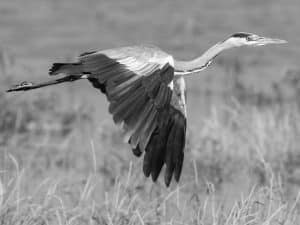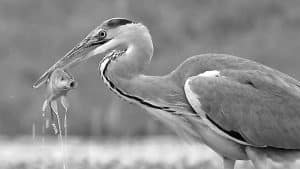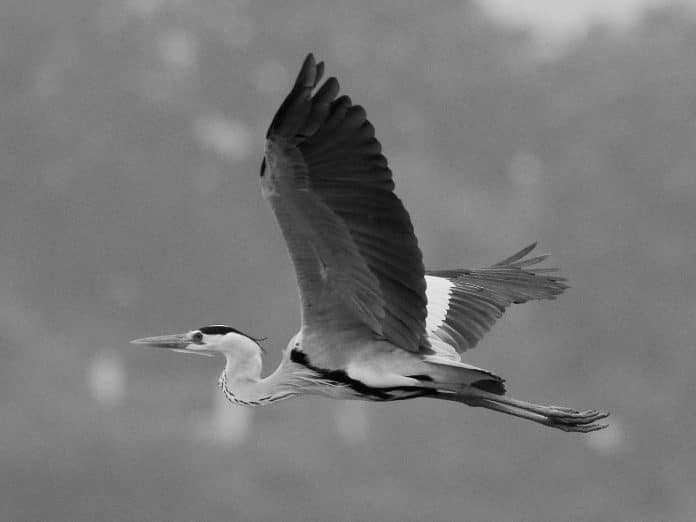Introduction to the Gray Heron in Tanzania
Tanzania, the land of diverse wildlife and untamed wilderness, is home to an array of magnificent bird species, including the majestic Gray Heron. This elegant bird, known for its grace and grandeur, has captivated the hearts of nature enthusiasts and birdwatchers from around the world. As you embark on a journey to explore the rich avian life of the Gray Heron in Tanzania stands out as a symbol of beauty and resilience in its natural habitat.

The Gray Heron, scientifically classified as Ardea cinerea, is a striking bird characterized by its long legs, slender neck, and distinct gray plumage. These birds are predominantly found in wetland areas, where they display their remarkable hunting prowess and distinctive behaviors. As you delve into the world of the Gray Heron in Tanzania, you will discover the fascinating aspects of its habitat, behavior, and the significant role it plays in the local ecosystem.
Habitat and Distribution of the Gray Heron
The habitat and distribution of the Gray Heron in Tanzania are closely intertwined with the country’s diverse landscape and rich biodiversity. These magnificent birds are commonly found in wetland habitats, including marshes, swamps, lakeshores, and riverbanks. The lush and verdant wetlands of Tanzania provide the perfect sanctuary for the Gray Heron to thrive and carry out its daily activities.
In Tanzania, the Gray Heron is distributed across various regions, with notable populations residing in the iconic Serengeti National Park, the sprawling Selous Game Reserve, and the picturesque Lake Manyara. These diverse habitats offer the Gray Heron abundant opportunities to forage for food, build nests, and engage in their unique mating rituals. As you explore the tranquil wetlands of Tanzania, the sight of these graceful birds wading through the shallow waters is a testament to their adaptability and resilience in their natural environment.
The presence of the Gray Heron in Tanzania’s wetlands is not only a testament to their adaptability and resilience in their natural environment, but also serves as a reminder of the delicate balance of ecosystems and the need for conservation efforts to safeguard their habitats.
Behaviors and Adaptations of the Gray Heron
The Gray Heron exhibits a remarkable array of behaviors and adaptations that showcase its prowess as a skilled hunter and a master of its environment. These birds are known for their patience and precision when hunting for prey, often standing motionless for extended periods before swiftly striking at unsuspecting fish or small aquatic creatures. Their long, dagger-like bills and sharp eyesight enable them to effortlessly capture their prey with remarkable accuracy.
In addition to their hunting prowess, the Gray Heron’s nesting and breeding behaviors are equally fascinating. During the breeding season, these birds engage in intricate courtship displays, with the males showcasing their elaborate plumage and engaging in aerial acrobatics to attract potential mates. The construction of their nests, often perched high in trees or nestled among reed beds, reflects their adaptability to varying environmental conditions and their instinctual drive to ensure the survival of their offspring.
As you observe the Gray Heron in its natural habitat, you will witness a symphony of behaviors that highlight their resilience, adaptability, and intrinsic connection to the wetland ecosystems of Tanzania.
Conservation Efforts for the Gray Heron in Tanzania

The conservation of the Gray Heron in Tanzania is of paramount importance to ensure the preservation of its natural habitats and the overall biodiversity of the region. As wetlands face increasing threats from human activities, including habitat loss, pollution, and climate change, concerted efforts are essential to mitigate these challenges and protect the vital ecosystems that sustain the Gray Heron and numerous other species.
Local conservation organizations and wildlife authorities in Tanzania have implemented various initiatives to safeguard the wetland habitats that are crucial to the survival of the Gray Heron. These efforts encompass habitat restoration projects, community-based conservation programs, and educational outreach to raise awareness about the significance of preserving the wetland ecosystems. By engaging local communities and fostering sustainable practices, conservationists aim to create a harmonious coexistence between human activities and the natural environment, thereby ensuring the long-term survival of the Gray Heron and its fellow inhabitants.
Through collaborative conservation endeavors and a shared commitment to environmental stewardship, the future of the Gray Heron in Tanzania holds promise, offering hope for the continued presence of these magnificent birds in the country’s untamed wilderness.
Best Places for Gray Heron Watching in Tanzania
Tanzania boasts a myriad of pristine locations that offer exceptional opportunities for observing the grace and grandeur of the Gray Heron in its natural habitat. Whether you are an avid birdwatcher, a wildlife photographer, or simply a nature enthusiast, these renowned destinations provide a captivating glimpse into the world of the Gray Heron and the enchanting wetlands that sustain its existence.
Serengeti National Park, renowned for its diverse wildlife and sweeping savannahs, is a prime location for encountering the Gray Heron amidst its captivating wetland habitats. The tranquil waters of Lake Manyara, nestled at the base of the Great Rift Valley, provide a picturesque setting for observing these elegant birds as they engage in their daily activities. The expansive wetlands of the Selous Game Reserve, with its meandering rivers and lush vegetation, offer a serene backdrop for witnessing the Gray Heron in its natural element.
As you embark on your journey to these breathtaking locales, the sight of the Gray Heron gracefully navigating the waters and perching in the verdant marshlands will leave an indelible impression, inviting you to immerse yourself in the splendor of Tanzania’s untamed wilderness.
Photography Tips for Capturing the Gray Heron
Capturing the essence of the Gray Heron in its natural habitat through photography requires a keen eye for detail, an understanding of its behaviors, and a deep appreciation for the art of visual storytelling. Whether you are an amateur photographer or a seasoned professional, these photography tips will enhance your ability to immortalize the beauty and elegance of the Gray Heron in Tanzania’s untamed wilderness.
- Patience and Persistence: Photographing the Gray Heron often demands patience and persistence, as these birds exhibit moments of stillness interspersed with sudden bursts of activity. By observing their behaviors and anticipating their movements, you can capture compelling images that convey the essence of their presence in the wetland habitats.
- Natural Lighting: The interplay of natural light in the wetland environments of Tanzania can create captivating visual narratives. Position yourself to take advantage of the soft, golden hues of sunrise or sunset, which lend a warm and ethereal quality to your photographs of the Gray Heron amidst its natural surroundings.
- Composition and Framing: Utilize the surrounding elements of the wetland landscape to frame your shots and create visually engaging compositions. Whether it’s the reflection of the Gray Heron in the tranquil waters or the juxtaposition of reeds and foliage, thoughtful composition can elevate your images and convey the harmony between the bird and its habitat.
By applying these photography tips and immersing yourself in the captivating world of the Gray Heron, you can craft a visual narrative that celebrates the untamed beauty of Tanzania’s wetlands and the mesmerizing presence of these graceful birds.
Local Myths and Legends Surrounding the Gray Heron

The presence of the Gray Heron in Tanzania’s wetlands has inspired a rich tapestry of local myths and legends that reflect the cultural significance of these majestic birds. Across various communities and indigenous traditions, the Gray Heron embodies symbolic meanings and narratives that intertwine with the natural landscapes and traditional beliefs of the region.
In the folklore of certain Tanzanian tribes, the Gray Heron is revered as a symbol of wisdom and foresight, attributed to its keen observation of its surroundings and its ability to navigate the waters with grace and poise. It is often depicted as a messenger between the earthly realm and the spirit world, embodying a spiritual connection to the natural elements and the cycles of life and renewal.
Furthermore, the striking appearance of the Gray Heron and its enigmatic presence in the wetlands have sparked tales of transformation and mystique, with some narratives portraying the bird as a guardian of hidden knowledge and mystical realms within the marshy landscapes. These enduring myths and legends serve as a testament to the profound impact of the Gray Heron on the cultural heritage and collective imagination of the people of Tanzania.
Research and Studies on the Gray Heron in Tanzania
The Gray Heron has been the subject of extensive research and scientific studies in Tanzania, shedding light on its ecological significance, behavioral patterns, and the intricate dynamics of its interactions within the wetland ecosystems. Through meticulous observation and empirical investigations, researchers have unraveled the complexities of the Gray Heron’s life history and its role in maintaining the ecological equilibrium of its habitats.
Studies have delved into various aspects of the Gray Heron’s behavior, including its foraging strategies, nesting habits, and migratory patterns, providing valuable insights into the ecological dynamics of wetland ecosystems. Additionally, research efforts have focused on the impacts of environmental changes, human disturbances, and anthropogenic activities on the populations and behaviors of the Gray Heron, emphasizing the need for conservation measures to safeguard their habitats.
Furthermore, collaborative research initiatives involving local scientists, conservationists, and international experts have contributed to a comprehensive understanding of the Gray Heron’s ecological significance, paving the way for informed conservation strategies and sustainable management practices in Tanzania’s wetland environments.
The Role of the Gray Heron in the Ecosystem
The Gray Heron occupies a pivotal role in the wetland ecosystems of Tanzania, exerting a profound influence on the ecological dynamics and the interconnected web of life within these vital habitats. As a top predator in the aquatic food chain, the Gray Heron plays a critical role in regulating the populations of fish, amphibians, and invertebrates, thereby contributing to the overall balance of the wetland communities.
Through their foraging activities, Gray Herons help control the abundance of small aquatic organisms, which in turn influences the structure and functioning of wetland ecosystems. Their presence also serves as an indicator of the health and vitality of the wetlands, offering valuable insights into the overall ecological integrity of these biodiverse landscapes.
Furthermore, the nesting behaviors of the Gray Heron contribute to the enrichment of wetland habitats, as their nesting sites provide refuge and shelter for a variety of other bird species, fostering a diverse and interconnected avian community within the wetlands. By nurturing this intricate tapestry of life, the Gray Heron perpetuates the resilience and vibrancy of the wetland ecosystems, underscoring its irreplaceable significance in the natural world.
Conclusion and Reflection on the Gray Heron’s Significance
As you immerse yourself in the captivating realm of the Gray Heron in Tanzania’s untamed wilderness, you are drawn into a world of timeless elegance and natural splendor. From the tranquil wetlands to the verdant marshes, the presence of these majestic birds resonates with a profound significance that transcends mere observation, inviting reflection on the interconnectedness of all life forms within the intricate tapestry of the natural world.
The grace and grandeur of the Gray Heron symbolize the resilience and adaptability of wildlife in the face of environmental challenges, embodying a testament to the enduring spirit of nature’s wonders. Through conservation efforts, research endeavors, and the preservation of cultural narratives, the Gray Heron’s significance in Tanzania’s wetlands extends beyond its ecological role, encompassing a legacy of inspiration, wisdom, and reverence for the natural world.


































